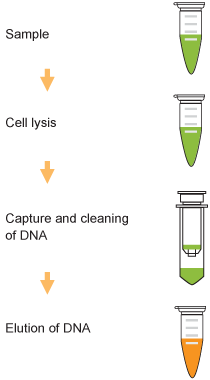DNA extraction
Unveiling the Genetic Code: The Fascinating Process of DNA Extraction
DNA extraction is a fundamental procedure in molecular biology that allows scientists to isolate and study the genetic material of living organisms. This process unlocks the secrets held within the double helix structure of DNA, providing valuable insights into genetic research, forensic science, and medical diagnostics. Let's delve into the captivating world of DNA extraction and explore the steps involved in this essential scientific procedure.
Harvesting the Genetic Treasure
Collecting the Sample: The first step in DNA extraction is to obtain a sample containing the genetic material of interest. This can be anything from a blood sample, tissue biopsy, saliva, or even plant material. The choice of sample depends on the organism being studied and the purpose of the DNA extraction.
Breaking Down the Cell
Cell Disruption: The collected sample undergoes a process of cell disruption to release the genetic material contained within the cells. This can be achieved through mechanical means, such as grinding or homogenization, or by using detergents and enzymes that break down the cell membranes and release the DNA.
Separating the DNA from Other Components
Removal of Proteins and Lipids: Once the cells are disrupted, the DNA needs to be separated from other cellular components, such as proteins and lipids. Enzymes, detergents, and organic solvents are used to remove these contaminants, leaving behind purified DNA.
Precipitation and Purification
DNA Precipitation: The purified DNA is then precipitated from the solution by adding alcohol, usually isopropanol or ethanol. The addition of alcohol causes the DNA to come out of solution and form a visible precipitate.
DNA Purification: The precipitated DNA is collected through centrifugation, where it forms a pellet at the bottom of the tube. The supernatant is discarded, and the DNA pellet is washed with a solution to remove any remaining contaminants.
Assessing DNA Quantity and Quality
Quantification and Analysis: The final step involves quantifying and analyzing the extracted DNA to determine its concentration and purity. This is typically done using spectrophotometry or fluorometry, which measure the amount of DNA present and assess its quality.
The Process of Discovery
Enabling Scientific Breakthroughs: DNA extraction is a crucial step in numerous scientific fields, enabling researchers to explore the mysteries of genetics and biology. It plays a pivotal role in fields such as genetic research, medical diagnostics, forensic science, and evolutionary biology.
Unveiling the Code of Life: DNA extraction allows us to unlock the secrets held within the genetic code, unraveling the complex blueprint that governs life. By studying the extracted DNA, scientists can gain insights into hereditary diseases, genetic variations, and evolutionary relationships.
DNA extraction is a foundational procedure that unlocks the vast potential of genetic information. By isolating and purifying DNA, scientists can delve into the complexities of life itself. From understanding the origins of species to diagnosing diseases and advancing scientific knowledge, DNA extraction is the key to unlocking the genetic secrets that shape our world.


תגובות
הוסף רשומת תגובה